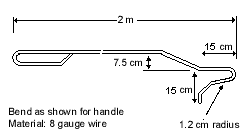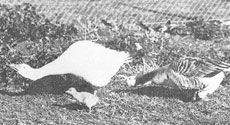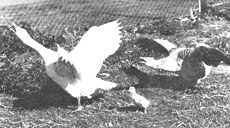
Handling geese, and using geese as 'watchdogs' and for weed control
Catching and handling geese
Always catch geese by the neck and never by the legs, as the legs are weak and easily injured or broken. To hold or carry a goose:

- Catch it by the neck, either with your hand or with a catching hook (see diagram at right).
- Pull the bird close to your body. Reach down with your other arm and wrap it around the bird’s body, holding the wings in place and grasping both legs with one finger between the legs.
- Lift the bird onto your arm and hand to the side of your body, so the head and neck protrude from under your arm.
Geese as ‘watchdogs’


Geese become excited and noisy if confronted by intruders or strange sounds. They respond by making a hissing sound, and for this reason make good ‘watchdogs’. The Chinese breed has been the most widely used for this purpose, though all breeds are suitable to some extent.
Geese for weed control
Because geese will eat weeds without harming certain cultivated crops, they can be used for weed control. It is not known why geese do not eat certain crops. Geese can be used for weed control in crops such as corn, cotton, ornamental plants, strawberries and sugarbeet, as well as in orchards and vineyards.
Geese of any age can be used for weed control. Provide birds with adequate shade and drinking water and a little prepared feed in the evening. Allow 7–15 geese/ha, and move them according to weed growth and stage of the crop.

